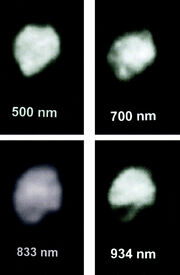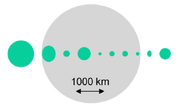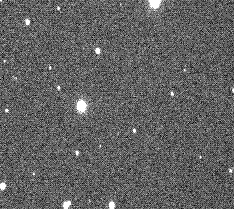3 Juno []

Juno seen at four wavelengths. A large crater appears dark at 934 nm.
3 Juno (jew'-noe (key)) was the third asteroid to be discovered and is one of the largest main belt asteroids, being the heaviest of the stony S-type. It was discovered on September 1, 1804 by German astronomer Karl L. Harding, using a humble 2-inch telescope. It was named after the mythological figure Juno, the highest Roman goddess. The adjectival form of the name is Junonian.
Characteristics[]

Size comparison: the first 10 asteroids profiled against Earth's Moon. Juno is third from the left.
Juno is one of the largest asteroids, containing approximately 1.0% the mass of the entire asteroid belt. In a ranking by size, it is in the lower teens. It vies with 15 Eunomia for the honour of being the largest of the stony S-type asteroids, although the newest estimates put Juno in second place. Amongst S-types it is unusually reflective, which may be indicative of different surface properties. It is the main body in the Juno family.
Juno rotates in a prograde direction, with the north pole pointing towards ecliptic coordinates (β, λ) = (27°, 103°) with a 10° uncertainty[1]. This gives an axial tilt of 51°.
Spectroscopic studies of the Junonian surface permit the conclusion that Juno could be the body of origin of ordinary chondrites, a common group of stony meteorites composed of iron-containing silicates such as olivine and pyroxene[2]. The maximum temperature on the surface, when the sun is overhead, was measured at about 293 K on October 2, 2001. Taking into account also the heliocentric distance at the time, gives an estimated maximum of 301 K (+28°C) at perihelion [3].
Infrared images reveal that it possesses an approximately 100 km wide crater or ejecta feature, the result of a geologically young impact[4].
Observations[]
Juno was the first asteroid for which an occultation was observed. It passed in front of a dim star (SAO 112328) on February 19, 1958. Since then, several occultations by Juno have been observed, the most fruitful being on December 11, 1979, which was registered by 18 observers.[5]
Radio signals from spacecraft in orbit around Mars and on its surface have been used to estimate the mass of Juno from the tiny perturbations induced by it onto the motion of Mars.[6] Juno's orbit appears to have changed slightly around 1839, very likely due to perturbations from a passing asteroid, whose identity has not been determined. An alternate but less likely explanation is an impact by a sizeable body.[7]
In 1996, Juno was imaged by the Hooker Telescope at Mount Wilson Observatory at visible and near-IR wavelengths, using adaptive optics. The images spanned a whole rotation period and revealed an irregular shape and a dark albedo feature, interpreted as a fresh impact site.[4]
 Juno moving across background stars. |
 Juno during opposition in 2009. |
Aspects[]
| Stationary, retrograde |
Opposition | Distance to Earth (AU) |
Maximum brightness (mag) |
Stationary, prograde |
Conjunction to Sun |
|---|---|---|---|---|---|
| November 2, 2005 | December 9, 2005 | 1.06025 | 7.5 | January 16, 2006 | February 24, 2005 |
| February 19, 2007 | April 10, 2007 | 2.13320 | 9.7 | June 5, 2007 | September 2, 2006 |
| April 18, 2008 | June 12, 2008 | 2.28071 | 10.1 | August 10, 2008 | November 14, 2007 |
| August 15, 2009 | September 21, 2009 | 1.18972 | 7.6 | October 31, 2009 | January 18, 2009 |
| January 24, 2011 | March 13, 2011 | 1.78236 | 8.9 | May 1, 2011 | July 10, 2010 |
| March 27, 2012 | May 20, 2012 | 2.37727 | 10.2 | July 20, 2012 | October 23, 2011 |
| June 14, 2013 | August 4, 2013 | 1.67506 | 8.9 | September 21, 2013 | December 23, 2012 |
| December 17, 2014 | February 1, 2015 | 1.33782 | 8.2 | March 12, 2015 | April 13, 2014 |
| March 7, 2016 | April 28, 2016 | 2.30641 | 10.0 | June 27, 2016 | September 28, 2015 |
| May 9, 2017 | July 3, 2017 | 2.07904 | 9.7 | August 27, 2017 | November 30, 2016 |
| October 20, 2018 | November 22, 2018 | 1.03276 | 7.4 | December 31, 2018 | February 16, 2018 |
| February 14, 2020 | April 4, 2020 | 2.07425 | 9.6 | May 29, 2020 | August 25, 2019 |
| April 14, 2021 | June 8, 2021 | 2.31368 | 10.1 | August 6, 2021 | November 9, 2020 |
References[]
- ↑ M. Kaasalainen et al Models of Twenty asteroids from photometric data, Icarus, Vol. 159, p. 369 (2002).
- ↑ M. J. Gaffey Mineralogical variations within the S-type asteroid class, icarus, Vol. 106, pp. 573 (1993).
- ↑ L. F. Lim et al Thermal infrared (8-13μm) spectra of 29 asteroids: the Cornell Mid-Infrared Asteroid Spectroscopy (MIDAS) Survey, Icarus, Vol. 173, pp. 385 (2005).
- ↑ 4.0 4.1 Mt Wilson Observatory S. Baliunas et al Multispectral analysis of asteroid 3 Juno taken with the 100-inch telescope at Mount Wilson Observatory, Icarus, Vol. 163, pp 135 (2003).
- ↑ Millis, R. L., Wasserman, L. H.; Bowell, E.; Franz, O. G.; White, N. M.; Lockwood, G. W.; Nye, R.; Bertram, R.; Klemola, A.; Dunham, E.; Morrison, D. (February 1981). "The diameter of Juno from its occultation of AG+0°1022". Astronomical Journal 86: 306–313. DOI:10.1086/112889.
- ↑ Pitjeva, E. V. (2004). "Estimations of masses of the largest asteroids and the main asteroid belt from ranging to planets, Mars orbiters and landers". 35th COSPAR Scientific Assembly. Held 18–25 July 2004, in Paris, France, 2014.
- ↑ Hilton, James L. (February 1999). "US Naval Observatory Ephemerides of the Largest Asteroids". Astronomical Journal 117 (2): 1077–1086. DOI:10.1086/300728. Retrieved on 2012-04-15.
External links[]
- Well resolved images from four angles taken at Mount Wilson observatory
- NASA Planetary Data System asteroid data sets
- Shape model deduced from light curve
See also[]
- List of Solar System bodies formerly considered planets
| Minor planets | ||
|---|---|---|
| Previous minor planet | 3 Juno | Next minor planet |
| List of asteroids | ||
| The minor planets |
|---|
| Vulcanoids | Near-Earth asteroids | Main belt | Jupiter Trojans | Centaurs | Damocloids | Comets | Trans-Neptunians (Kuiper belt · Scattered disc · Oort cloud) |
| For other objects and regions, see: asteroid groups and families, binary asteroids, asteroid moons and the Solar system For a complete listing, see: List of asteroids. See also Pronunciation of asteroid names and Meanings of asteroid names. |